

 |

|
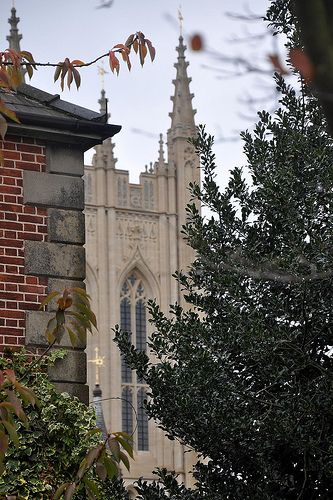 Bury St. Edmundsbury St. Edmunds Cathedral, Suffolk, England where Thomas Bacon was christened in 1620.
Bury St. Edmundsbury St. Edmunds Cathedral, Suffolk, England where Thomas Bacon was christened in 1620.
Sir Nicholas Bacon
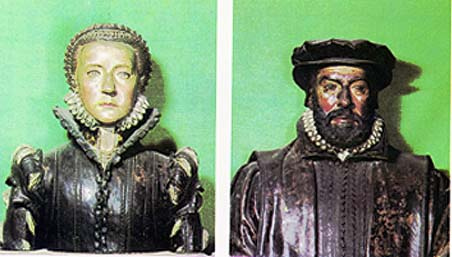 Bust of Sir Nicholas Bacon and wife, Anne. Sir Nicholas Bacon, born 28 December 1510, died 20 February 1579), was an English politician during the reign of Queen Elizabeth I of England, and the Lord Keeper of the Great Seal. Also, He was the father of the philosopher and statesman Sir Francis Bacon. Sir Nicholas graduated from Corpus Christi College, Cambridge in 1527, then entered Gray's Inn (the bar in 1533). Following the Dissolution of the Monasteries, Henry VIII gave him a grant of the manors of Redgrave, Botesdale, Gislingham, and Gorhambury.
Sir Nicholas Bacon was twice married and by his first wife, Jane Ferneley, had three sons and three daughters. In 1553 he married his second wife Anne, daughter of Sir Anthony Cooke, by whom he had two sons, Anthony Bacon (born 1558, died 1601) and Francis Bacon (1561 to 1626). Lady Anne Bacon [nee Coke], born ca 1528, died in 1610, was an English gentlewoman and scholar, Lady in Waiting to Queen Elizabeth. She made a lasting contribution to English religious literature with her translation from Latin of John Jewel's Apology of the Anglican Church (1564). Lady Anne was born in Essex, England, one of the five daughters of Anthony Cooke, tutor to Edwin, the only son of Henry VIII. Cooke ensured that each daughter received a thorough humanist education in languages and the classics. Anne excelled in Greek, Latin, and Italian. At twenty-two, she translated and published Barnardine Ochyne of Siena's work Ochines Sermons from the Italian. Her translation from Latin into English of Bishop John Jewel's work of 1564 Apology for the Church of England was a significant step in the intellectual justification of Protestantism in England. The work was a clarification of the differences between Anglicanism and Roman Catholicism and was critical to the support of the religious politics of Queen Elizabeth I. She married Sir Nicholas Bacon, Queen Elizabeth's Lord Chancellor, in 1553.
In 1545, Sir Nicholas Bacon was a Member of Parliament, representing Dartmouth; the following year was made Attorney of the Court of Wards and Liveries. As a Protestant, he lost preferment under Queen Mary I of England. However, upon the accession of her younger sister Elizabeth in 1558, he was appointed Lord Keeper of the Great Seal, largely owing to the influence of his brother-in-law William Cecil. Shortly afterward, Bacon was knighted. In 1564 he fell temporarily into the royal disfavor and was dismissed from court, because Elizabeth suspected he was concerned in the publication of a pamphlet, A Declaration of the Succession of the Crowne Imperial of England, by John Hales, which favored the claim of Lady Catherine Grey, the sister of Lady Jane Grey.
Bust of Sir Nicholas Bacon and wife, Anne. Sir Nicholas Bacon, born 28 December 1510, died 20 February 1579), was an English politician during the reign of Queen Elizabeth I of England, and the Lord Keeper of the Great Seal. Also, He was the father of the philosopher and statesman Sir Francis Bacon. Sir Nicholas graduated from Corpus Christi College, Cambridge in 1527, then entered Gray's Inn (the bar in 1533). Following the Dissolution of the Monasteries, Henry VIII gave him a grant of the manors of Redgrave, Botesdale, Gislingham, and Gorhambury.
Sir Nicholas Bacon was twice married and by his first wife, Jane Ferneley, had three sons and three daughters. In 1553 he married his second wife Anne, daughter of Sir Anthony Cooke, by whom he had two sons, Anthony Bacon (born 1558, died 1601) and Francis Bacon (1561 to 1626). Lady Anne Bacon [nee Coke], born ca 1528, died in 1610, was an English gentlewoman and scholar, Lady in Waiting to Queen Elizabeth. She made a lasting contribution to English religious literature with her translation from Latin of John Jewel's Apology of the Anglican Church (1564). Lady Anne was born in Essex, England, one of the five daughters of Anthony Cooke, tutor to Edwin, the only son of Henry VIII. Cooke ensured that each daughter received a thorough humanist education in languages and the classics. Anne excelled in Greek, Latin, and Italian. At twenty-two, she translated and published Barnardine Ochyne of Siena's work Ochines Sermons from the Italian. Her translation from Latin into English of Bishop John Jewel's work of 1564 Apology for the Church of England was a significant step in the intellectual justification of Protestantism in England. The work was a clarification of the differences between Anglicanism and Roman Catholicism and was critical to the support of the religious politics of Queen Elizabeth I. She married Sir Nicholas Bacon, Queen Elizabeth's Lord Chancellor, in 1553.
In 1545, Sir Nicholas Bacon was a Member of Parliament, representing Dartmouth; the following year was made Attorney of the Court of Wards and Liveries. As a Protestant, he lost preferment under Queen Mary I of England. However, upon the accession of her younger sister Elizabeth in 1558, he was appointed Lord Keeper of the Great Seal, largely owing to the influence of his brother-in-law William Cecil. Shortly afterward, Bacon was knighted. In 1564 he fell temporarily into the royal disfavor and was dismissed from court, because Elizabeth suspected he was concerned in the publication of a pamphlet, A Declaration of the Succession of the Crowne Imperial of England, by John Hales, which favored the claim of Lady Catherine Grey, the sister of Lady Jane Grey. Sir Nicholas Bacon died at Gorhambury and was buried in St. Paul's Cathedral, his death calling forth many tributes to his memory. |
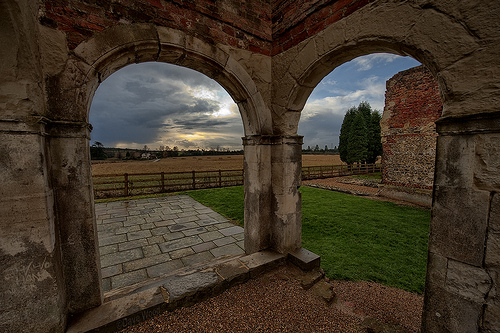 Gorhambury belonged to St Alban's Abbey and lay near the site of the vanished Roman city of Verulamium (modern-day St Albans).
From 1563 to 1568 Sir Nicholas Bacon built the Old Gorhambury House, which later became the home of
Sir Francis Bacon, his youngest son!
Gorhambury belonged to St Alban's Abbey and lay near the site of the vanished Roman city of Verulamium (modern-day St Albans).
From 1563 to 1568 Sir Nicholas Bacon built the Old Gorhambury House, which later became the home of
Sir Francis Bacon, his youngest son!
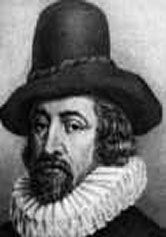 Sir Francis Bacon. The Elizabethan mansion of Gorhambury House was located near St Albans, Hertfordshire, England is an Elizabethan mansion. It was built ca 1563 by Sir Nicholas Bacon, Lord Keeper, and was twice visited by Queen Elizabeth. The house was built partly from bricks taken from the old Abbey buildings at St Alban's, then in process of demolition following the Benedictine priory's dissolution some 25 years earlier. It was used as a residence by his youngest son, the polymath (scientist, philosopher, statesman, and essayist) Sir Francis Bacon, before being bequeathed by him to his former secretary, Sir Thomas Meautys, who married Anne Bacon, the great-granddaughter of the Lord Keeper. The estate passed in 1652 to Anne's second husband Sir Harbottle Grimston. |
1676. Nathaniel Bacon's Rebellion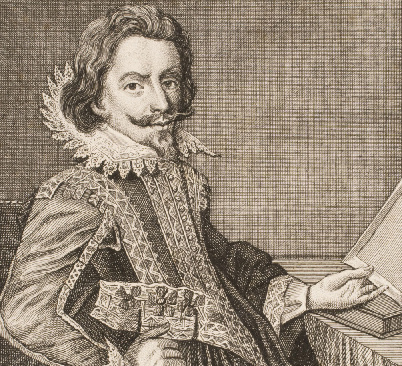 Nathaniel Bacon, the rebel, had cousins in New Kent County, Virginia. Nathaniel became famous when he set about protecting the settlers from Indian raids. Nathaniel Bacon, a respected member of the House of Burgesses, was labeled a rebel, but actually, he was a hero. The citizens of Virginia were continually harassed, axed, and taken as slaves by local Indians. Although complaints went out, the Royal Governor Berkeley refused to do anything. Finally, Nathaniel Bacon of Surry County organized a group of citizens to clear the area of Indians. This entire fiasco was political in origin, especially by the Royal Governor. Ultimately, the affair ended with the Governor's troops seeking out the Bacon gang. In the process, the town of Jamestown was burned to the ground, and members of the gang were hanged. Nathaniel Bacon would have been hanged had he not been ill and died. The Royal Governor, in fear of his consequences, left Williamsburg and returned to England. It was fearful for colonists. Nathaniel Bacon, the rebel, had cousins in New Kent County, Virginia. Nathaniel became famous when he set about protecting the settlers from Indian raids. Nathaniel Bacon, a respected member of the House of Burgesses, was labeled a rebel, but actually, he was a hero. The citizens of Virginia were continually harassed, axed, and taken as slaves by local Indians. Although complaints went out, the Royal Governor Berkeley refused to do anything. Finally, Nathaniel Bacon of Surry County organized a group of citizens to clear the area of Indians. This entire fiasco was political in origin, especially by the Royal Governor. Ultimately, the affair ended with the Governor's troops seeking out the Bacon gang. In the process, the town of Jamestown was burned to the ground, and members of the gang were hanged. Nathaniel Bacon would have been hanged had he not been ill and died. The Royal Governor, in fear of his consequences, left Williamsburg and returned to England. It was fearful for colonists.
|
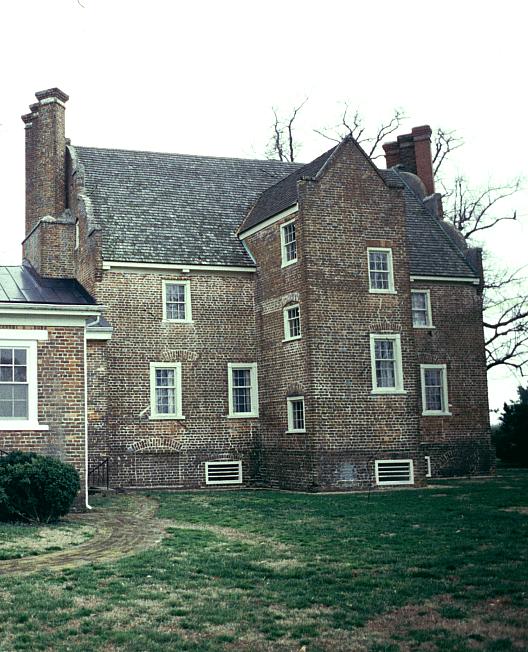 Bacon's Castle in Surry County, Virginia. Fireplace, with a brick hearth and timber lintel. An outside kitchen was constructed during the 18th century.
Bacon's Castle in Surry County, Virginia. Fireplace, with a brick hearth and timber lintel. An outside kitchen was constructed during the 18th century.
|